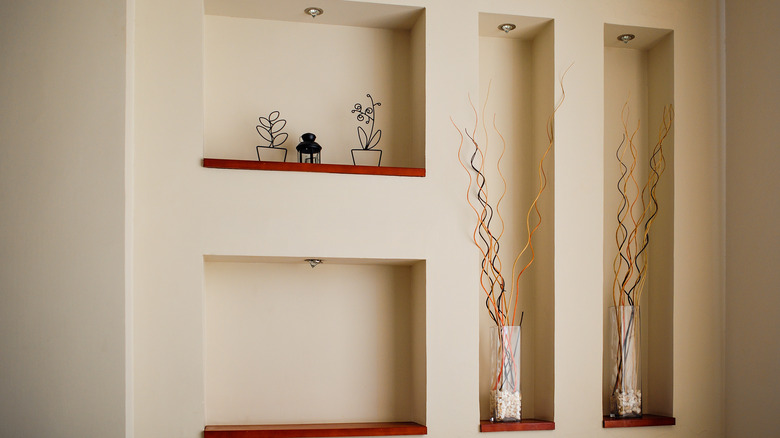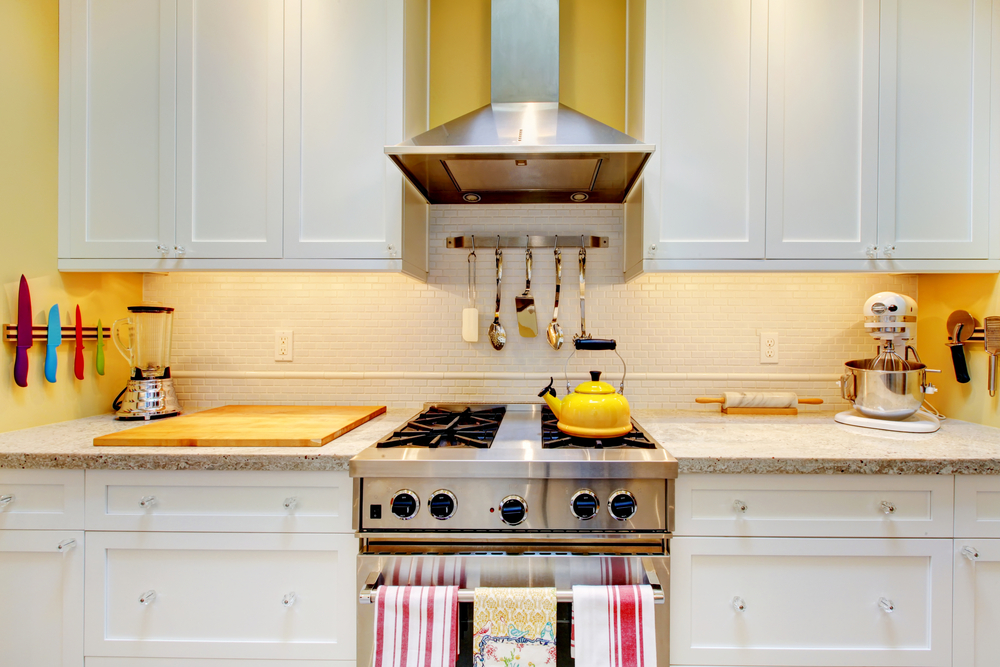Recessed Cabinet Design and Installation

Recessed cabinets are a clever and stylish solution for maximizing space in stud walls, offering a seamless integration that enhances both functionality and aesthetics. These cabinets create a sense of depth and sophistication, making them a popular choice for homeowners seeking to optimize their storage solutions.
Installing Recessed Cabinets
Installing recessed cabinets requires careful planning and execution to ensure a seamless integration with the wall. This process involves creating a cavity within the stud wall, which will house the cabinet. The following steps Artikel the installation process:
- Planning and Design: Determine the desired cabinet size, depth, and location. Consider the surrounding wall features and ensure the cabinet dimensions align with the available space. Draw a detailed plan outlining the cabinet’s position and dimensions.
- Framing the Cavity: Using stud wall construction techniques, create a frame for the recessed cabinet. This involves constructing a box within the wall using wood framing members, ensuring the dimensions match the planned cabinet size.
- Installing the Cabinet: Once the cavity is framed, carefully install the cabinet within the recessed space. Secure the cabinet to the framing using screws or brackets, ensuring stability and alignment.
- Finishing: Finish the recessed cabinet installation by adding trim or molding around the cabinet opening to create a seamless transition between the cabinet and the wall.
Design Considerations
Recessed cabinets offer a variety of design options, allowing homeowners to tailor their storage solutions to specific needs and preferences. Here are some key considerations for designing recessed cabinets:
- Cabinet Size and Depth: The size and depth of the cabinet are crucial factors to consider. Ensure the cabinet dimensions are proportionate to the available space and the intended purpose.
- Material Choices: Recessed cabinets can be constructed from various materials, including wood, metal, and plastic. The choice of material depends on the desired aesthetic, durability, and budget.
- Door and Hardware: Select cabinet doors and hardware that complement the overall design style. Consider options such as sliding doors, hinged doors, or tambour doors, depending on the available space and desired functionality.
Cabinet Styles and Room Types
Recessed cabinets can be adapted to suit various room types, offering tailored storage solutions for different needs. Here is a table showcasing different cabinet styles and their suitability for different rooms:
| Cabinet Style | Room Type | Description |
|---|---|---|
| Open Shelving | Kitchen, Bathroom, Living Room | Open shelving provides easy access to items and a minimalist aesthetic. |
| Closed Cabinets with Doors | Kitchen, Bathroom, Bedroom | Closed cabinets with doors offer discreet storage and protection from dust and moisture. |
| Medicine Cabinets | Bathroom | Medicine cabinets are designed for storing toiletries and medications, often featuring a mirrored front. |
| Wine Cabinets | Dining Room, Kitchen | Wine cabinets are specifically designed for storing and displaying wine bottles. |
Recessed Cabinet Types and Features

Recessed cabinets offer a sleek and space-saving solution for organizing and storing items in various settings, from homes to offices. They integrate seamlessly into walls, maximizing available space and creating a streamlined aesthetic. Let’s explore the diverse types of recessed cabinets and the features that make them so versatile.
Types of Recessed Cabinets
The type of recessed cabinet you choose will depend on your specific needs and the space you have available. Here are the most common types:
- Wall-Mounted Recessed Cabinets: These cabinets are directly attached to the wall, typically using a frame or brackets. They are ideal for smaller spaces and can be customized to fit specific needs, such as storing books, electronics, or decorative items.
- Floor-Mounted Recessed Cabinets: As the name suggests, these cabinets rest on the floor and are often used in larger spaces. They can be freestanding or integrated into a wall unit. They offer ample storage space and are perfect for storing larger items like appliances, clothing, or tools.
- Combination Recessed Cabinets: These cabinets combine elements of both wall-mounted and floor-mounted designs. They may have a base that sits on the floor and an upper section that is attached to the wall, creating a unified storage solution. This type is particularly versatile and can be adapted to different spaces and needs.
Common Features of Recessed Cabinets
Recessed cabinets come with a variety of features that enhance their functionality and aesthetics. Here are some of the most common features:
- Adjustable Shelves: This feature allows you to customize the interior of the cabinet to accommodate items of different sizes. You can adjust the shelf height to create more or less space, depending on your needs.
- Doors: Doors can be hinged, sliding, or even roll-up, providing a secure and visually appealing way to conceal the contents of the cabinet. They also help to protect items from dust and damage.
- Drawers: Drawers are a great way to organize smaller items and keep them easily accessible. They can be integrated into the cabinet design or added as separate units.
- Lighting Options: Recessed cabinets can be equipped with built-in lighting, such as LED strips, to illuminate the interior. This feature is especially useful for cabinets that are located in darker areas or for showcasing items that need to be highlighted.
Innovative Recessed Cabinet Designs, Recessed cabinet for stud walls
Modern design trends have led to innovative recessed cabinet designs that push the boundaries of functionality and aesthetics. Here are some examples:
- Integrated Organizers: Some recessed cabinets feature built-in organizers, such as pull-out trays, dividers, and baskets. These features make it easy to keep items sorted and organized.
- Hidden Compartments: These cabinets can be designed with hidden compartments that provide extra storage space for valuable or sensitive items. These compartments are often concealed behind a panel or door, providing added security.
- Multifunctional Designs: Recessed cabinets can be designed to serve multiple purposes. For example, a cabinet can be used as a storage unit, a display shelf, or even a workspace.
Visual Representation of a Recessed Cabinet
Imagine a recessed cabinet integrated into a living room wall. The cabinet is floor-mounted and features a sleek, modern design. The exterior is finished in a rich walnut veneer, complementing the surrounding décor. The cabinet has two sliding doors that reveal a spacious interior. Inside, there are adjustable shelves, a pull-out tray for organizing small items, and a hidden compartment behind a concealed panel. The cabinet is equipped with LED lighting that illuminates the interior when the doors are open.
Recessed Cabinet Applications and Customization: Recessed Cabinet For Stud Walls

Recessed cabinets offer a unique blend of functionality and aesthetics, seamlessly integrating into various spaces while maximizing storage potential. Their ability to blend seamlessly with walls creates a streamlined look, while their customized design options cater to diverse needs and preferences.
Applications of Recessed Cabinets
Recessed cabinets are versatile and can be incorporated into various rooms, enhancing both functionality and aesthetics. They are particularly popular in:
- Living Rooms: Recessed cabinets can be used to house entertainment systems, creating a sleek and integrated look. They can also be used to display books, artwork, or other decorative items.
- Bedrooms: Recessed cabinets can be used as wardrobes, providing ample storage space for clothing, accessories, and other personal belongings. They can also be used to create a dedicated space for a dressing table or vanity.
- Kitchens: Recessed cabinets can be used to store appliances, cookware, and other kitchen essentials. They can also be used to create a pantry or a dedicated coffee bar.
- Bathrooms: Recessed cabinets can be used to store toiletries, towels, and other bathroom essentials. They can also be used to create a medicine cabinet or a dedicated space for a hairdryer or curling iron.
- Home Offices: Recessed cabinets can be used to store office supplies, files, and other work-related items. They can also be used to create a dedicated space for a computer or a printer.
Customization Options
Recessed cabinets offer a wide range of customization options to suit individual needs and preferences:
- Size: Recessed cabinets can be custom-sized to fit any space, from small alcoves to entire walls. This ensures optimal utilization of available space and a perfect fit for the room.
- Style: Recessed cabinets can be designed in various styles to complement the overall décor of the room. From traditional to modern, there is a style to match every taste and preference.
- Functionality: Recessed cabinets can be equipped with various features to enhance their functionality, such as adjustable shelves, pull-out drawers, and integrated lighting. These features cater to specific storage needs and provide easy access to contents.
Integration with Other Home Features
Recessed cabinets can be seamlessly integrated with other home features, creating a cohesive and functional design:
- Built-in Appliances: Recessed cabinets can be designed to accommodate built-in appliances, such as refrigerators, ovens, or dishwashers, creating a streamlined and integrated kitchen design.
- Lighting Systems: Recessed cabinets can be incorporated into lighting systems, providing ambient or task lighting within the cabinet. This enhances visibility and creates a sophisticated and functional design.
Recessed cabinet for stud walls – Recessed cabinets are a fantastic way to maximize space in your stud walls, adding a touch of elegance and functionality. However, if you’re planning a major renovation or simply fancy a change, you might find yourself needing to remove those cabinets.
Fortunately, there are plenty of resources available to guide you through the process, like this handy step-by-step guide on removing cabinets from wall. Once you’ve tackled that task, you can then decide if you want to re-install those cabinets, find a new home for them, or perhaps even embrace a more minimalist aesthetic with your stud walls.
Recessed cabinets in stud walls are a fantastic way to maximize space and create a sleek, integrated look. But if you’re looking to showcase a collection of miniature treasures, consider a wall curio cabinet instead. These cabinets offer dedicated display space with glass doors, allowing your miniature masterpieces to shine.
Of course, if you’re dealing with larger items, a recessed cabinet is still a wise choice, offering a clean and clutter-free solution.